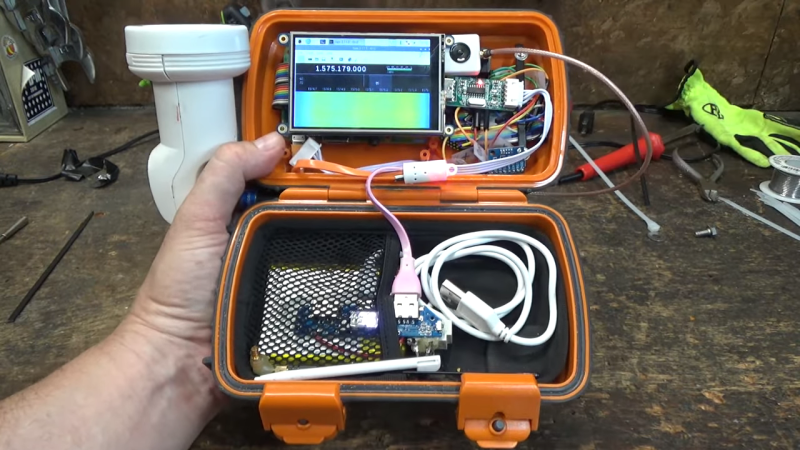With an ever-growing constellation of Starlink satellites whizzing around over our heads, you might be getting the urge to start experimenting with the high-speed internet service. But at $100 or more a month plus hardware, the barrier to entry is just a little daunting for a lot of us. No worries, though — if all you’re interested in is tracking [Elon]’s birds, it’s actually a pretty simple job.
Now, we’re not claiming that you’ll be able to connect to Starlink and get internet service with this setup, of course, and neither is the delightfully named [saveitforparts]. Instead, his setup just receives the beacon signals from Starlink satellites, which is pretty interesting all by itself. The hardware consists of his “Picorder” mobile device, which sports a Raspberry Pi, a small LCD screen, and a host of sensors, including an RTL-SDR dongle. To pick up the satellite beacons, he used a dirt-cheap universal Ku-band LNB, or low-noise block downconverter. They’re normally found at the focal point of a satellite TV dish, but in this case no dish is needed — just power it up with a power injector and point it to the sky. The signals show up on the Picorder’s display in waterfall mode; curiously, the waterfall traces look quite similar to the patterns the satellites make in the night sky, much to the consternation of astronomers.
Of course, you don’t have to have a Picorder to snoop in on Starlink — any laptop and SDR should work, despite [saveitforparts]’ trouble in doing so. You shouldn’t have much trouble replicating the results by following the video below, which also has a few tips on powering an LNB for portable operations.
[via RTL-SDR.com]















It’s nice to see, but all it does is display the signals in a waterfall diagram. Nothing else. The title of the article made me think there was some decoding involved.
The Starlink Ku-Band beacon frequency is 11.325GHz so a 10GHz L.O. LNB or a 9.75GHz Universal LNB (22kHz Off for Low Band) would be ideal for this. I am surprised that a measurable signal can be obtained without the use of dish to focus the signal into the feed horn of the LNB.
IDK what their power budget is, but I do know that the Starlink birds are a lot closer than the geosynch TV birds. Possibly have narrower beams too.
Hi, a GEO is at 36000 km altitude, a NGSO Starlink is roughly at 360 km, therefore a difference in ratio of 20 dB, I.e. propagation loss 40 dB less for GSO than a NGSO Starlink. A dish has around 24 dBi, resulting in a margin of 16 dB. Of course, the transmitting downlink power is lower at NGSO, but remains a lot dor a good reception without the dish.
To fix what I said, the GSO loss due to propagation is higher with 40 dB in comparison with VLEO Starlink satellite. From here, the budget link is far better, allowing lower / no dishes and lower terminals (lower unlink transmission power) than in the case of GSO. Again of 24 dBi is one of the best for a GSO terminal, in fact is much lower. Therefore, the margin is better.
this device can read outernet to?
Outerwear is not longer uploading data to the L-Band IntelSat. They stopped some time ago.
Starlink is $100 or more a month?? I presume that’s supposed to go down at some point
$110 plus the $500 for the equipment. Well, worth it for me, compared to the $70 I paid AT&T for the promised 6 down .5 up DSL, with a 150G Datacap. Received mine in April 2022, preordered Feb. 8th 2021. My Starlink speed rivals the offered speed of the fiber that we have been promised for years.
Same here. I had 3Mbps DSL from AT&T for 8 years. While I’m not getting the speeds anticipated from Starlink (around 50Mbps,) it still feels like I’m finally back out of the Stone Age!
$500 for the equipment? SL must have ripped me off then. To get a dish delivered it was $700. Then I needed an Ethernet adapter to go with it
The cost for equipment went up to $600 earlier this year for new orders, plus shipping, and I think first months fee.
Compared to traditional geo stationary based internet, it is both a bargain & blisteringly quick (despite the reported slow downs in North America)
I’ve often wondered if someone couldn’t use the signals to make a pretty accurate “GPS” system as there are/will be a significant number of them up there
Depends if they have a time base managed by an atomic clock
It’s been done
https://hackaday.com/2021/10/10/gps-with-starlink-we-dont-need-it-any-more/
If those are signals from different satellites, why would the traces be parallel to each other? The Doppler shift for a low Earth orbit satellite changes non-linearly up and down as the satellite approaches the receiver and then flies away. And that would happen at different times for different satellites.
I think the drift that we see here maybe dominated by the thermal drift of the local oscillator in the down-converter.
Or maybe, there are frequency difference between the satellites that are received belonging to different planes or different angular positions in a specific plane of the constellation.
its not drift. Each satellite has multiple CW
I have a brand new unit still in the box. Iwas one of the original beta testers but quickly discovered I had too many trees and never used it. A couple weeks ago. When I tried to use it again, I discovered the software for the modem was so far put of date that it couldn’t be updated. Anyone looking for a new dish to replace a damaged one, I have one, just make me an offer.
Contact SL and they’ll help you get either a software update or new modem.